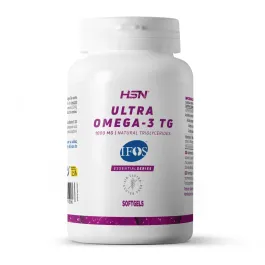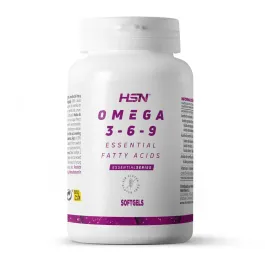
OMEGA-3 FISH OIL 1.000mg
1000 mg fish oil high in omega 3 (EPA and DHA). Authentic 18% EPA + 12% DHA -> 180mg EPA + 120mg DHA per softgel. With natural vitamin E which protects the omega-3 fatty acids. Sourced from the oil of small, cold-water Atlantic fish. Free of contaminants and oxidation (No PCBs, Dioxins, Furans, Peroxidation, or Anisidine). Odourless and tasteless. Guaranteed quality and complete molecular distillation.





PREMIUM OMEGA-3 TG (IFOS) 1000mg

ULTRA OMEGA-3 TG (IFOS) 1000mg

OMEGA 3-6-9 1000mg

COD LIVER OIL 1000mg

KRILL OIL 500mg

VEGAN OMEGA-3 ALGAE OIL 1000mg

IRON BISGLYCINATE Ferrochel™ (30mg IRON)

OPC COMPLEX (GRAPE SEED EXTRACT)
- Omega-3 from natural fish oil. A high content of EPA and DHA fatty acids.
- 180mg Eicosapentaenoic Acid + 120mg Docosahexaenoic Acid (Authentic 18/12%), per softgel.
- It contains a good amount of Vitamin E as an antioxidant for guaranteed protection of omega fatty acids.
- It provides 1000mg of fish oil certified as high in omega-3, per softgel. High dose.
- Guaranteed absence of fatty acid oxidation, maximum purity.
- No contamination, fish oil is free of heavy metals. Completely molecularly distilled.
- Stability assured: Controlled acid value: Omega-3 of the highest quality! Free of PCBs and Dioxins.
Don't be fooled!
Our Omega-3 Fish Oil 1000mg guarantees a real content per softgel of 180mg of eicosapentaenoic acid (EPA) and 120mg of docosahexaenoic acid (DHA).
Find out why we specifically state the amounts of Omega-3 and why this is necessary while other companies only state the percentages.
Table of contents
Natural fish oil with a High Omega-3 content
Omega-3 Fish Oil 1000mg by EssentialSeries is a food supplement in softgels made from clean, high-quality fish oil, with a guaranteed content of omega-3 fatty acids, highly valued for their nutritional properties, especially in the Western diet where their intake is quite deficient compared to the ideal.
How many times have you eaten oily fish in the last week? And seaweed? These two are the main sources of omega-3 fatty acids in the diet, and realistically? In the West, unlike in regions such as Japan where fish consumption is widespread, their intake is not sufficient. Omega-3 food supplements are an excellent way to supplement the diet of people who do not consume large amounts of omega-3-rich foods.
HSN Omega-3 Fish Oil is a food supplement that meets all the necessary specifications of quality, maximum purity, and guaranteed fatty acid content; to be a reference product in the international market.
Authentic quality Omega-3
The quality of the omega-3 fatty acids is important as the oily fish from which the omega-3-rich oil is obtained is very susceptible to contamination, degradation, or inadequate properties, and to ensure this, the companies that sell it must control everything necessary.
At hsn we participate in the whole process, and enjoy a unique development in quality and safety!
Guaranteed content. HSN Omega-3 is measured in mass, not volume
The omega-3 fatty acids are a part of the fish oil contained in the softgels, this is always the case in all products on the market, that is, there is no such thing as a '100% Omega-3' product because it is not possible.
The amount of omega-3 present in fish oil must be measured after processing, which guarantees a certain content, usually, 18% / 12%, which is the most common.
There is a problem with this, and that is that it is confusing:
If I tell you that 18% of the product is EPA, and the softgel has 1000mg of fish oil? How much EPA does it contain? 180mg, right? It should be, but it depends.
Usually, companies state fatty acid percentages based on the volume of the softgel, although this is valid, in our view, it is a complete fraud for the consumer, as it is easily misleading.
When you measure the 18% volumetric content of the softgel, there is not 180mg of EPA, but around 160mg, i.e., it is actually 16% EPA by mass. You think you are consuming more than it actually has and you are paying for it!
At HSN we measure the omega-3s in our products by mass, which is why our 1000mg fish oil omega-3s are authentic 18% EPA / 12% DHA, by mass, meaning each 1000mg softgel provides 180mg EPA and 120mg DHA.
We are completely transparent and offer the best quality on the market at an unbeatable price.
A small, clean, molecularly distilled fish oil
The fish oil that is encapsulated in the softgel has a natural origin, and this is always the case too, but of course... Not all fish oil is the same, that is, it is not the same to obtain fish oil from a sardine as from salmon.
Small fish, such as sardines and anchovies, are ideal sources of omega-3 fatty acid supplementation oils.
This is because other common species such as salmon have a much larger skin surface area and therefore tend to pick up more of the pollutants and metals, such as mercury, to which they are exposed in the sea. Small fish are not subjected to this and therefore, naturally, the purity of their oil is much higher.
In addition, the fish oil from which HSN's omega-3 is made has been molecularly distilled, a special purification process for omega-3s that removes any traces of heavy metals and natural contaminants from the marine environment that may be present in the fish oil from which the food supplement is developed.
Full supply of essential fatty acids, 0% peroxidation due to quality control and antioxidants
The fish, once caught, are steamed to obtain their oil. This is the way we follow at HSN and is the ideal way to ensure that the omega-3 fatty acids are not peroxidised, as the steam does not significantly raise the temperature of the fish fat from which the oil is obtained and therefore does not degrade it.
Likewise, the whole process of treatment and conservation of the oil, as well as the manufacturing of the softgel and its subsequent storage is aimed at guaranteeing the absence of oxidation of the oil and its essential fatty acids.
Not to mention that a significant amount of vitamin E has been added to HSN's product, an antioxidant powerhouse that helps protect cells from oxidative damage. It is this property that also protects the fatty acids in the fish oil softgels from oxygen, light, and oxidation, ensuring their enhanced integrity.
High Unit Dose: 1000mg Fish Oil (180mg EPA / 120mg DHA) per softgel
We have already mentioned the importance of measuring the omega-3s in mass and not in the volume of the softgel, but not only that is important, we must also take into account that the gross amount of encapsulated fish oil per unit is also important.
For example, if the softgels are small and contain 500mg of fish oil (which is often the case), even if the EPA content is a genuine 18%, they will only provide 90mg each, and you will end up using many more softgels daily.
HSN softgels provide 1000mg of real fish oil per unit, a high concentration ideal for convenient food supplementation.
Free of dioxins and derived compounds. Free of anisidine, furans, and PCBs
The purity of the fish oil is established based on its content of contaminants such as dioxins, furans, and PCBs.
Omega-3 fish oil by HSN is free of these and other contaminants naturally present in marine fish from environmental exposure.
It also does not contain anisidine which is a measure of the deterioration of fish oil, and therefore a marker of quality loss.
Free from colourings, flavourings, and preservatives. Natural fish oil and gelatine softgel product
Omega-3 softgels by HSN are free from colourings, preservatives, and flavour masking agents.
They are pure omega-3-rich fish oil softgels with vitamin E. The most natural!
They do not contain unnecessary additives and do not need anything to camouflage their organoleptic properties, because thanks to the quality control of the glazing agent: They are tasteless, odourless, and more comfortable to use.
Fish oil from cold water origin. Better quality and less exposure to contaminants
The cold waters of the Atlantic are the locations where the seawater is purest and cleanest, and therefore where the animals living there are exposed to the least pollution.
The small fish from which the omega-3 oil in our food supplements is made are caught in these carefully selected locations to ensure that the original raw material (the fish) used to make the oil is already of the highest quality.
The properties of Omega-3 will surprise you. discover the importance of these essential fatty acids in your health
Omega-3 Fish Oil 1000mg by HSN is a food supplement with a high Omega-3 content.
The main constituents of this family of fatty acids are:
- Alpha-linolenic acid (ALA).
- Eicosapentaenoic acid (EPA).
- Docosahexaenoic acid (DHA).
Docosahexaenoic acid (DHA)
- Docosahexaenoic acid helps maintain normal brain function. 1
- Docosahexaenoic acid contributes to the maintenance of normal vision.2
EPA + DHA
- Eicosapentaenoic and docosahexaenoic acids contribute to normal heart function.3
As you can see, the importance of omega-3 fatty acids is very high, especially for the care of the most sensitive organs of the human body such as the brain, heart and eyes.
Make sure you ensure an adequate intake of omegas with our high-quality food supplement!!
Tips and tricks so that omega-3 does not repeat itself. our softgels have no smell or taste!
A common problem for omega-3 consumers is that these types of food supplements, because they have a high concentration of fish oil, can 'repeat', making your mouth taste fishy after hours of use.
This is common in people who use omega-3s on an empty stomach, and HSN advises against this mode of use, as it is less effective in the first place, and contributes to this undesirable effect of omega-3s.
The best recommendation to avoid these effects is to take the softgels with a meal, preferably a light one, without dairy or leguminous foods that can generate gas and contribute to repeat eating.
Get to know all our Omega-3s. essential fatty acids for all needs
At HSN, we have different types of Omega-3 that differ fundamentally in the concentration of their EPA and DHA content. We present them to you:
| Product | EPA | DHA |
| Omega-3 Fish Oil 1000mg | 180mg | 120mg |
| Ultra Omega-3 (TG) 1000mg | 350mg | 250mg |
| Premium Omega-3 (TG) 1000mg | 500mg | 250mg |
| Cod liver oil 1000mg | 80mg | 90mg |
| Vegan Omega-3 Algae Oil 1000mg | - | 400mg |
| Krill Oil 500mg | 50mg | 27,5mg |
Which one is ideal for you?
Bibliographical references
- Albert, B. B., Derraik, J. G. B., Cameron-Smith, D., Hofman, P. L., Tumanov, S., Villas-Boas, S. G., … Cutfield, W. S. (2015). Fish oil supplements in New Zealand are highly oxidised and do not meet label content of n-3 PUFA. Scientific Reports, 5, 7928.
- Bonilla-Mendez, J. R., & Hoyos-Concha, J. L. (2018). Methods of extraction, refining and concentration of fish oil as a source of omega-3 fatty acids. Corpoica Ciencia y Tecnologia Agropecuaria, 19(3), 645–668.
- EFSA Panel on Dietetic Products, N. and A. (NDA). (2009). Scientific Opinion on the substantiation of health claims related to eicosapentaenoic acid (EPA), docosahexaenoic acid (DHA), docosapentaenoic acid (DPA) pursuant to Article 13(1) of Regulation (EC) No 1924/2006. EFSA Journal, 7(10), 1263.
- EFSA Panel on Dietetic Products, N. and A. (NDA). (2010). Scientific Opinion on the substantiation of health claims related to docosahexaenoic acid (DHA) pursuant to Article 13(1) of Regulation (EC) No 1924/2006. EFSA Journal, 8(10), 1734.
- Kris-Etherton, P. M., Harris, W. S., & Appel, L. J. (2002). Fish consumption, fish oil, omega-3 fatty acids, and cardiovascular disease. Circulation, 106(21), 2747–2757.
1 The effect is achieved with a daily intake of 250mg DHA.
2 The effect is achieved with a daily intake of 250mg DHA.
3 The effect is achieved with a daily intake of 250mg EPA and DHA.
Nutritional FactsOMEGA-3 FISH OIL 1000mg - 120 softgels |
| daily doseper serving |
| Serving size: 1 softgel | ||
| daily dose: 3 softgels | ||
| Servings per container: 120 | ||
| Daily amount | |||
|---|---|---|---|
| Fish Oil | 3000mg | ||
| Omega 3 fatty acids (EPA + DHA) | 900mg | ||
| Eicosapentanoic Acid EPA (Omega 3) | 540mg | ||
| Docosahexanoic acid DHA (Omega 3) | 360mg | ||
| Vitamin E (as D-alpha-tocopherol) | 40.2mg | ||
| NRVs (Nutrient Reference Values) established in Regulation (EU) 1169/2011 of 25 October 2011. †† NRVs are not established on this occasion. |
Ingredients
Fish oil [18% eicosapentaenoic acid (EPA), 12% docosahexaenoic acid (DHA)], gelatine, humectant (glycerine), D-alpha-tocopherol (natural vitamin E).
Warnings
Store in a cool (below 25°C), dry and dark place. Do not exceed the stated recommended daily dose. Keep out of reach of the smallest children. Nutritional supplements should not be used to replace a balanced diet. It is necessary to maintain a varied and balanced diet and a healthy lifestyle. Health claim awaiting European authorization.

How to take OMEGA-3 FISH OIL 1000mg - 120 softgels
Take 1 softgel, 3 times a day with meals.
The product reviews and opinions published reflect only the customers’ views and experiences. HSN does not verify or endorse such comments or claims, and is not responsible for the content provided in the reviews. Statements regarding food supplements have not been evaluated by the EFSA (European Food Safety Authority) and are not intended to diagnose, treat, cure, or prevent any disease or medical condition.
The product reviews and opinions published reflect only the customers’ views and experiences. HSN does not verify or endorse such comments or claims, and is not responsible for the content provided in the reviews. Statements regarding food supplements have not been evaluated by the EFSA (European Food Safety Authority) and are not intended to diagnose, treat, cure, or prevent any disease or medical condition.

A satisfied customer says:
Excellent omega 3.
Inma ortiz 09/02/2024
I have been taking Omega 3 from HSN for less than a month and I must say that I have been surprised by the quality of the capsules, they are easy to take and the best thing is that they do not repeat, I had problems with other brands that had a fishy taste. I don't eat fish of any kind and taking omega provides me with Omega contribution to my organism.
Show original language
A critical customer says:
Good
Fpp 16/06/2023
No taste. Fulfills its function, leaves a fishy reflux in the throat. Reasonable price. I keep buying it
Show original language-
Good product
Blancu 01/12/2025
Perhaps the format is too large, especially considering that you have to take 3 a day. Perhaps more compact would be better.
Show original languageWas the review helpful? Be thefirst one to rate the review -
Quality and good price
Jose 24/11/2025
Have been taking them for months and recommend them. They are easy to ingest and are better priced than most on the market.
Show original languageWas the review helpful? Be thefirst one to rate the review -
GREAT PRODUCT
J. ANTONIO 22/11/2025
The capsules are easy to swallow and do not leave any fishy taste or repeat anything, very comfortable to take.
Show original languageWas the review helpful? Be thefirst one to rate the review -
Good product
amir 14/11/2025
Most Omega-3 supplements give me stomach pain, especially the vegan ones. This one is good, and the pills do not stick together like they do with other brands.
Was the review helpful? Be thefirst one to rate the review -
Excellent
Txori 14/11/2025
I take it every morning when I wake up.indispensable in my day.better pay a little more,your body deserves it.to complete my diet.
Show original languageWas the review helpful?1 people found it useful
No reviews found with filters applied.
{title}
{nickname-date}
{detail}
{review-link} EN - EUR
EN - EUR Albania
Albania  Austria
Austria  Belgique
Belgique  Bosnia and Herzegovina
Bosnia and Herzegovina  Bulgaria
Bulgaria  Canadá
Canadá  Chile
Chile  Chipre
Chipre  Corea (la República de)
Corea (la República de)  Croacia
Croacia  Czechia
Czechia  Denmark
Denmark  Deutschland
Deutschland  Eslovaquia
Eslovaquia  Eslovenia
Eslovenia  Estonia
Estonia  Finland
Finland  France
France  Greece
Greece  Hungary
Hungary  Iceland
Iceland  Ireland
Ireland  Islas Feroe
Islas Feroe  Italia
Italia  Japan
Japan  Latvia
Latvia  Lithuania
Lithuania  Luxembourg
Luxembourg  Macedonia
Macedonia  Malta
Malta  Marruecos
Marruecos  Mónaco
Mónaco  Montenegro
Montenegro  Netherlands
Netherlands  Noruega
Noruega  Poland
Poland  Portugal
Portugal  Romania
Romania  Schweiz
Schweiz  Serbia
Serbia  South Africa
South Africa  Suecia
Suecia 

 View full analysis
View full analysis 






